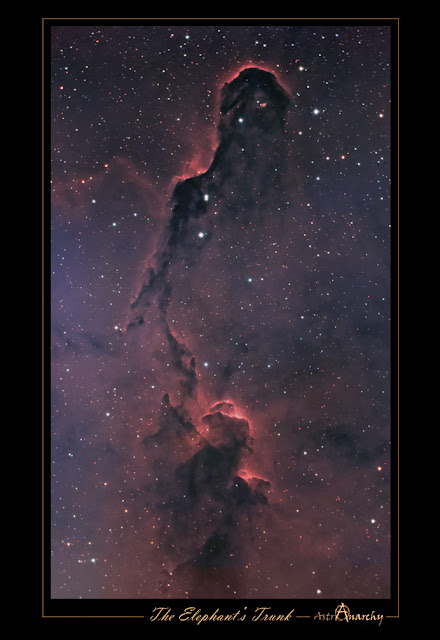COPYRIGHT, PLEASE NOTE
All the material on this website is copyrighted to J-P Metsavainio, if not otherwise stated. Any content on this website may not be reproduced without the author’s permission.
BUY A MUSEUM QUALITY POSTER
BUY A POSTER:https://astroanarchy.zenfolio.com/
Saturday, October 31, 2009
LRGB Elephant's Trunk

I had an older version of the Elephant's Trunk from the year 2007.
It was a H-aRGB image.
This is a combination of the olde and the new images.
It can be called to a H-a, O-III and S-II boosted RGB image.
Friday, October 30, 2009
The Elephant's Trunk Nebula


In Natural colors In HST-palette - This is a detail from the Nebula IC 1396, a beautiful, sculpture like, gas formation. HERE is a wider field of view to same object. - Technical details: Two color chemes, HST Palette as S-II=Red, H-a=Green and O-III=Blue. Second image is in natural colors composed from narrowband data. Channels are balanced so, that image match to visible spectrum, H-a + 24%S-II=Red, O-III=Green and O-III + 15%H-alpha=Blue. Processing work flow: Image acquisition, MaxiDL v5.07. Stacked and calibrated in CCDStack. Deconvolution with a CCDSharp, 30 iterations. Levels, curves and color combine in PS CS3. Telescope, Meade LX200 GPS 12" @ f4.65 Camera, QHY9 Guiding, SXV-AO @ 11Hz Image Scale, 0,8 arcseconds/pixel Exposures: H-alpha 17x1200s Binned 1x1 O-III 4x600s, binned 3x3 S-II 6x600s, binned 3x3
Monday, October 19, 2009
Cat's Eye Nebula, Stereogram

Parallel Vision
 Cross Vision - -
Cross Vision - -
 Cross Vision - -
Cross Vision - -
NOTE! This is a personal vision about forms and shapes, based on some known facts and artistic impression. Wieving instructions can be found from a Right hand side menu. - Original Image with details can be found HERE.
-
Cat's Eye Stereogram in a HST-palette
Labels:
stereo images
Cat's Eye Nebula


Outer shell is very dim and the core of the Nebula is so bright, balancing that is not an easy task.
I'm happy with this result!
The core of the Cat's Eye Nebula has a small angular diameter, so good seeing is needed to reveal any internal details. I managesd to get some visible by using seceral relatively short exposures, 150s. each, for the core. Seeing varys between 3-2,2 FWHM.
There is a hint of cocentric circles visible around the core, ,they are real phenomen coused by polarized light from the nebula.
 Gropped center from the image above.
Gropped center from the image above.
They are very well seen in Hubble's image of the Cat's Eye Nebula HERE:
-
Two color chemes, HST Palette as S-II=Red, H-a=Green and O-III=Blue. Second image is in natural colors composed from narrowband data. Channels are balanced so, that image match to visible spectrum, H-a + 24%S-II=Red, O-III=Green and O-III + 15%H-alpha=Blue. - Processing work flow: Image acquisition, MaxiDL v5.07. Stacked and calibrated in CCDStack. Deconvolution with a CCDSharp, 30 iterations. Levels, curves and color combine in PS CS3. Mild wavelets to the core with RegiStax5 - -Telescope, Meade LX200 GPS 12" @ f4.65 Camera, QHY9 Guiding, SXV-AO @ 11Hz Image Scale, 0,8 arcseconds/pixel Exposures: H-alpha 9x1200s Binned 1x1 + 22x300s Binned 1x1 for the Core O-III 12x1200s, binned 1x1 + 15x150s Binned 1x1 for the Core S-II 4x600s, binned 1x1
Subscribe to:
Comments (Atom)










